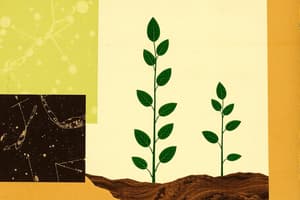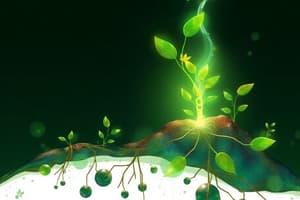Podcast
Questions and Answers
What role does chlorophyll play in photosynthesis?
What role does chlorophyll play in photosynthesis?
- It stores sugars generated during photosynthesis.
- It acts as a carbon dioxide reservoir.
- It is involved in cellular respiration.
- It reflects green light and absorbs red and blue light. (correct)
What is the significance of carbon fixation in plants?
What is the significance of carbon fixation in plants?
- It helps in generating water through the photosynthesis process.
- It allows plants to take in oxygen during the dark.
- It converts inorganic carbon into organic molecules. (correct)
- It serves as the primary energy source for plant growth.
What differentiates C4 photosynthesis from C3 photosynthesis?
What differentiates C4 photosynthesis from C3 photosynthesis?
- C4 relies on a spatial separation of carbon fixation and the Calvin cycle. (correct)
- C4 occurs in cooler environments only.
- C4 requires more sunlight than C3 photosynthesis.
- C4 involves a temporal separation of carbon fixation.
Which statement accurately describes the relationship between photosynthesis and cellular respiration?
Which statement accurately describes the relationship between photosynthesis and cellular respiration?
Which process occurs during the light-dependent reactions of photosynthesis?
Which process occurs during the light-dependent reactions of photosynthesis?
What is a defining characteristic of CAM photosynthesis?
What is a defining characteristic of CAM photosynthesis?
How do plants optimize light capture for photosynthesis?
How do plants optimize light capture for photosynthesis?
What is the primary reason C3 photosynthesis is less efficient in hot, dry conditions?
What is the primary reason C3 photosynthesis is less efficient in hot, dry conditions?
Flashcards
Photosynthesis
Photosynthesis
The process where plants use sunlight to make food (sugars) from carbon dioxide and water. It releases oxygen as a byproduct.
Chloroplasts
Chloroplasts
Specialized organelles inside plant cells where photosynthesis takes place.
Light-dependent Reactions
Light-dependent Reactions
The first stage of photosynthesis, where light energy is captured by chlorophyll and converted into chemical energy (ATP and NADPH).
Light-independent Reactions (Calvin cycle)
Light-independent Reactions (Calvin cycle)
Signup and view all the flashcards
Chlorophyll
Chlorophyll
Signup and view all the flashcards
Carbon Fixation
Carbon Fixation
Signup and view all the flashcards
C4 Photosynthesis
C4 Photosynthesis
Signup and view all the flashcards
CAM Photosynthesis
CAM Photosynthesis
Signup and view all the flashcards
Study Notes
Photosynthesis Overview
- Photosynthesis is the process used by green plants and some other organisms to create food from carbon dioxide and water using sunlight.
- It's a fundamental biological process essential for life on Earth, producing oxygen and being the primary energy source for many ecosystems.
- The process takes place in chloroplasts, specialized components within plant cells.
- Photosynthesis involves two key stages: the light-dependent reactions and the light-independent reactions (Calvin cycle).
Plants as Solar Energy Converters
- Plants absorb light energy from the sun using pigments like chlorophyll.
- Chlorophyll primarily absorbs red and blue light, reflecting green light.
- This absorbed light energy energizes electrons, triggering the photosynthetic process.
- Converting light energy into chemical energy (sugars) is vital for plant growth and survival.
- Different wavelengths of light are absorbed differently by chlorophyll and other pigments, maximizing light capture.
Plants as Carbon Dioxide Fixers
- Plants absorb carbon dioxide from the atmosphere.
- Carbon dioxide is a crucial input for photosynthesis.
- Through carbon fixation, plants incorporate atmospheric carbon dioxide into organic molecules (sugars).
- This conversion of inorganic carbon into organic compounds is essential for producing food and building plant tissues.
- This process helps regulate the Earth's atmospheric carbon dioxide levels.
Alternative Pathways for Photosynthesis
- C3, C4, and CAM photosynthesis are different methods plants use to adapt to various environmental conditions, especially high temperatures and dry environments.
- C3 photosynthesis is the most common method, found in many plants, but it's less efficient in hot and dry climates.
- C4 photosynthesis separates carbon fixation from the Calvin cycle in specialized cells, enhancing efficiency at higher temperatures.
- CAM (Crassulacean Acid Metabolism) photosynthesis has a temporal separation. Stomata open at night to absorb CO2, storing it as an acid, and releasing it during the day for photosynthesis when stomata are closed to minimize water loss.
Photosynthesis vs Cellular Respiration
- Photosynthesis and cellular respiration are complementary processes in the biosphere.
- Photosynthesis transforms light energy into chemical energy (sugars), storing this energy in organic molecules.
- Cellular respiration breaks down these sugars, releasing energy for cellular activities.
- Photosynthesis produces oxygen, a byproduct crucial for cellular respiration.
- Cellular respiration produces carbon dioxide, a reactant used in photosynthesis.
- Both processes are vital for maintaining the balance of energy transfer and carbon cycling in ecosystems.
- Photosynthesis takes in carbon dioxide and water, releasing oxygen (O2), whereas respiration takes in oxygen and releases carbon dioxide and water.
- Photosynthesis is an anabolic process (building molecules), while cellular respiration is a catabolic process (breaking down molecules).
Studying That Suits You
Use AI to generate personalized quizzes and flashcards to suit your learning preferences.




